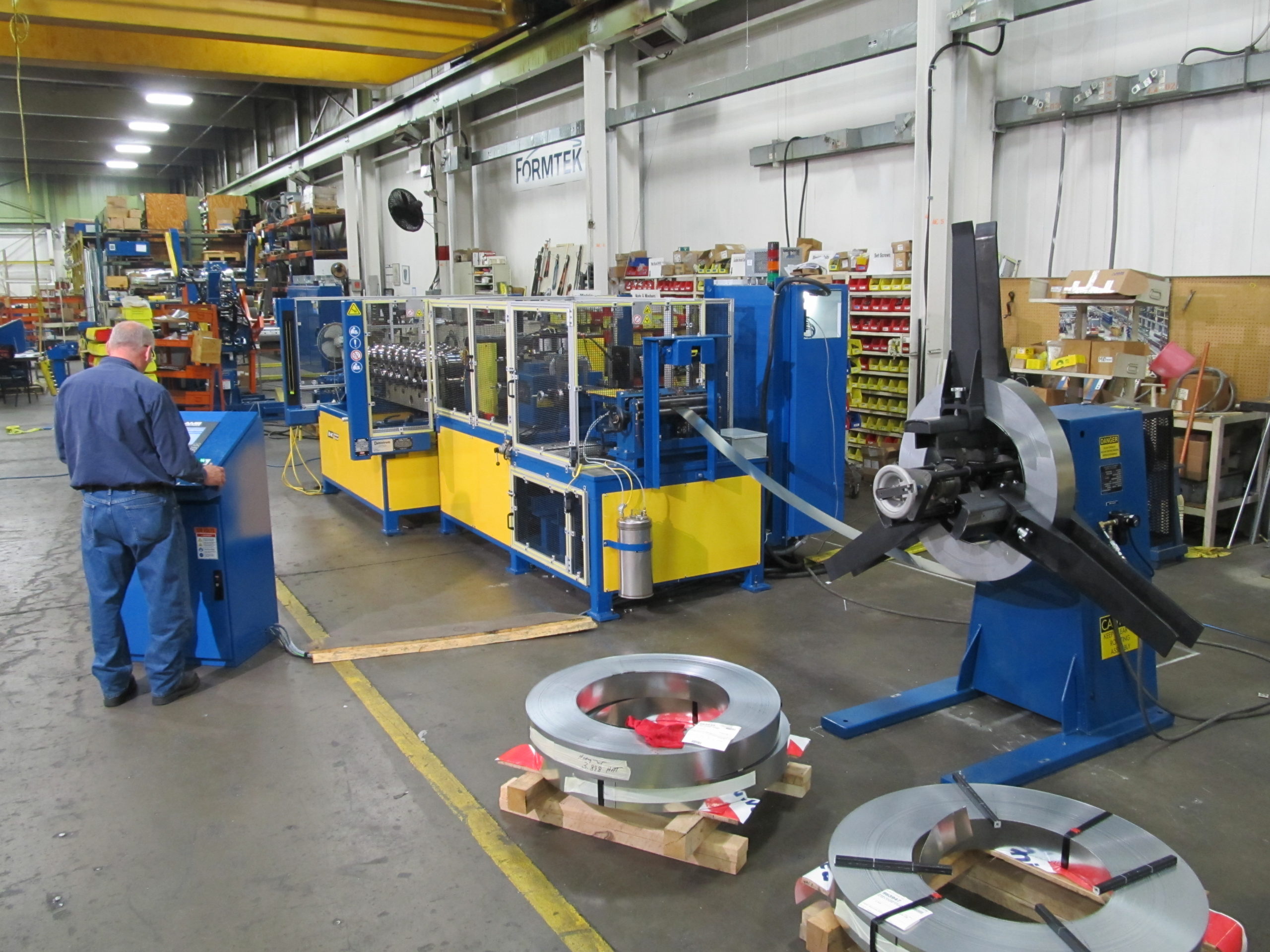As a follow up to our recent blog examining the potential pitfalls to the roll-forming process, this discussion will focus on how advanced technology has virtually eliminated these costly and aggravating hindrances with recent innovations.
Product Changeover
This is a significant challenge to productivity due to the many processes that take place – from complete removal of a tool set to an entire machine reset. Over the course of time, technological advancements have been made that virtually mitigate or minimize these burdens on time and efficiency.
- Duplex and telescoping shaft machines: this equipment provides movable banks of inboard and outboard housings to allow for quick changes in part width and eliminate the changing cross section of material thickness
- Rafted roll forming machines: this machine is typically used to change out an entire bank of roll tooling. The steel plate (known as the “raft”) along with the inboard and outboard housings and roll tooling for one job, is removed from the roll former base and replaced with another containing the tooling for the next job
- Roll formers featuring 2-side mounted roll tooling: this machine is powered by a single drive and allow product to be made on one set while the other set is changed out. In addition you can find roll formers that have a supplemental set of intermediate passes, which are significantly taller than the others to allow for an upper and lower roll tooling setup
Recent Innovations Yield Impressive Renovations
Manufacturers of roll forming devices have long observed the need to develop systems around specific types or “families” of products used in specific industries. The focal point should always be on the method that delivers the most significant cost savings and efficiencies. Select the process that produces stock in high volume based on the similarity of the product such as geometric characteristics (like items include steel framing, studs, track, joists and other structural building components). These building items are usually “C” or “U” shaped with variation being expressed in material thickness, web width, flange height and return leg length – product lengths are extremely variable as well as their corresponding number and types of holes. With recent innovations combined with proven technology advancements, the costly obstacles to machine set-up, adjustments for material change up, product changeover and operator training have been drastically reduced to a fraction of the previous years.
Machine Set-up
Roll forming systems are arranged to yield specific groups or “families” of products – this enables the manufacturer to perform the entire process – from the initial set-up of the machine to locking in a high level of product accuracy. Newer machine set-ups eliminate the typical obstacles that are often found with tooling prints, set-up charts, feeler gages, shims and spacers.
Material Change-up
While alterations in material thickness can be significant even within the same family of products, the new roll forming systems compensate for this with roll tooling clearances that can be adjusted from .015” to .125” in seconds. This key feature is handled by the adjustment set point that is either input into a PLC (programmable logic controller) or through push button activation. During this process the operator does not need to perform any manual adjustments or changes to the roll tooling or the roll former.
Operator Training
 Industry advancements also include the extensive training available to operators, which allows them to engineer alterations to the materials mechanical properties (such as yield, tensile, hardness) while the roll former is running. These state-of-the-art roll formers include stations that control the amount of overbend to each side of the product as well as adjustment for part “up-bow” and “down-bow” that is made to the inboard and outboard legs separately. The operator makes all of these adjustments at the push button control panel and motor.
Industry advancements also include the extensive training available to operators, which allows them to engineer alterations to the materials mechanical properties (such as yield, tensile, hardness) while the roll former is running. These state-of-the-art roll formers include stations that control the amount of overbend to each side of the product as well as adjustment for part “up-bow” and “down-bow” that is made to the inboard and outboard legs separately. The operator makes all of these adjustments at the push button control panel and motor.
Benefiting from Advancements
In addition to the benefits of less time lost due to product changeover and adjustments for material changeover, the contemporary roll forming system offers distinct productivity advancement when running a product. Roll formers can now run at speeds almost two times as fast as what is considered normal production of larger framing sections. Fabrication speeds can easily exceed 300 feet per minute for large joists made from heavy gauge material, while increasing to 400 or 500 feet per minute for smaller, thinner steel “drywall” products.
The steel framing market welcomes and enjoys the productivity gains of these leading edge roll forming systems. Producers document upsurges in productivity of nearly 30% over traditional roll formers and comment that achieving the maximum advantage of the new systems is now limited only by the time lost to loading and threading coils and moving finished product away from the roll forming line. Additionally the flexibility of these systems has dramatically shortened the delivery time to customers and can easily provide a variety of goods on short notice. While typically geared to the steel framing industry, the fundamental innovations will now be applied to greater array of products in multi-faceted industries.
To Learn More, check out our white paper:
About the Author
B&K is a member of the Formtek Group. Formtek is a group of long-established companies, each with a well-known name and a history of providing innovative, reliable equipment to the metal forming and metal processing industries. As a single source provider, Formtek continues to supply its customers with the highest quality equipment, parts and service available in the industries it serves.




